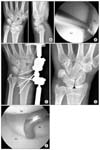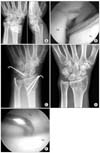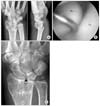Abstract
Purpose
The purpose of this study was to analyze the relationship between intercarpal ligament injuries associated with distal radius fracture and the fracture patterns and radiologic parameters, and to report on the clinical results of arthroscopic treatment for these injuries.
Materials and Methods
Fifty-two patients who underwent arthroscopic surgery for intercarpal ligaments injuries associated with distal radius fracture and who had a minimum 1 year follow-up were enrolled. There were 44 patients who sustained scapholunate interosseous ligament injury (SLIL) and 30 patients who sustained lunotriquetral interosseous ligament (LTIL) injury. Among them, 22 patients had both SLIL and LTIL injuries. The carpal ligament injuries were graded according to the Geissler classification and they treated with arthroscopic debridement only for a grade I and II injury and arthroscopic reduction and percutaneous pinning for a grade III and IV injury. The patients were divided into two groups and we assessed the functional and radiological outcomes: Group 1 consisted of the patients with a grade I and II injury and group 2 consisted of the patients with a grade III and IV injury.
Results
The preoperative mean radial inclination of group 2 with lunotriquetal interosseous ligament injury was 15.1±9.9°, which was significantly different from 20.4±5.1° of group 1, and the extra-articular type injury was more common in group 2 (p<0.05). On the follow-up radiographs, the mean scapholunate interval measured 2.1±0.5 mm in group 1 and 1.7±0.5 mm in group 2, which was significantly different (p<0.05).
Figures and Tables
 | Figure 1(A) Preoperative radiographs of a 30-year-old man showed an AO type C2 distal radius fracture of his wrist. (B) Midcarpal view showed a grade III scapholunte interosseous ligament injury according to the Geissler classification system.5) (C) The scapholunate joint was fixated with a K-wire under arthroscopic control. (D) Twenty-four month follow-up radiograph showed normal carpal alignment without carpal dissociation, and (E) which was demonstrated by second-look midcarpal arthroscopy. Sc, scaphoid; Lu, lunate; Cp, capitate. |
 | Figure 2(A) Preoperative radiographs of a 37-year-old man showed an AO type A3 distal radius fracture of his wrist. (B) Midcarpal view showed a grade III lunotriquetral interosseous ligament injury according to the Geissler classification. (C) The lunotriquetral interosseous ligament injury was treated with trans-lunotriquetral K-wire fixation after debridement under arthroscopy. (D) Fifteen month follow-up radiograph and (E) second-look arthroscopy showed normal carpal alignment without instability. Tq, triquetrum; Lu, lunate. |
 | Figure 3(A) Preopeative radiographs of a 42-year-old woman showed an AO type A3 distal radius fracture of her wrist. (B) The scapholunate interosseous ligament was considered as grade II injury. (C) Eighteen month follow-up radiograph after arthroscopic debridement without pinning showed static carpal instability with a 2.8 mm scapholunate gap. Sc, scaphoid; Lu, lunate. |
Table 1
Prevalence of Intercarpal Ligaments and TFCC Injuries Associated with Distal Radius Fractures

References
1. Forward DP, Lindau TR, Melsom DS. Intercarpal ligament injuries associated with fractures of the distal part of the radius. J Bone Joint Surg Am. 2007. 89:2334–2340.

2. Lindau T, Hagberg L, Adlercreutz C, Jonsson K, Aspenberg P. Distal radioulnar instability is an independent worsening factor in distal radial fractures. Clin Orthop Relat Res. 2000. (376):229–235.

3. Wiesler ER, Chloros GD, Mahirogullari M, Kuzma GR. Arthroscopic management of distal radius fractures. J Hand Surg Am. 2006. 31:1516–1526.

4. Lindau T, Arner M, Hagberg L. Intraarticular lesions in distal fractures of the radius in young adults. A descriptive arthroscopic study in 50 patients. J Hand Surg Br. 1997. 22:638–643.
5. Geissler WB, Freeland AE, Savoie FH, McIntyre LW, Whipple TL. Intracarpal soft-tissue lesions associated with an intra-articular fracture of the distal end of the radius. J Bone Joint Surg Am. 1996. 78:357–365.

6. Earp BE, Waters PM, Wyzykowski RJ. Arthroscopic treatment of partial scapholunate ligament tears in children with chronic wrist pain. J Bone Joint Surg Am. 2006. 88:2448–2455.

7. Geissler WB. Intra-articular distal radius fractures: the role of arthroscopy? Hand Clin. 2005. 21:407–416.

8. Walsh JJ, Berger RA, Cooney WP. Current status of scapholunate interosseous ligament injuries. J Am Acad Orthop Surg. 2002. 10:32–42.

9. Müler M, Nazarian S, Koch P. Classification of AO des fractures. 1987. Berlin: Springer-Verlag;106–115.
10. Cooney WP, Bussey R, Dobyns JH, Linscheid RL. Difficult wrist fractures. Perilunate fracture-dislocations of the wrist. Clin Orthop Relat Res. 1987. (214):136–147.
11. Cautilli GP, Wehbé MA. Scapho-lunate distance and cortical ring sign. J Hand Surg Am. 1991. 16:501–503.

12. Ruch DS, Vallee J, Poehling GG, Smith BP, Kuzma GR. Arthroscopic reduction versus fluoroscopic reduction in the management of intra-articular distal radius fractures. Arthroscopy. 2004. 20:225–230.

13. Mayfield JK, Johnson RP, Kilcoyne RK. Carpal dislocations: pathomechanics and progressive perilunar instability. J Hand Surg Am. 1980. 5:226–241.

15. Viegas SF, Patterson RM, Peterson PD, et al. Ulnar-sided perilunate instability: an anatomic and biomechanic study. J Hand Surg Am. 1990. 15:268–278.

16. Brown IW. Volar intercalary carpal instability following a seemingly innocent wrist fracture. J Hand Surg Br. 1987. 12:54–56.

17. Kim BS, Ahn JH, Choy WS, Kim HY, Park JG. Scapholunate dissociation associated with distal radius fracture. J Korean Orthop Assoc. 2004. 39:265–270.

18. Doi K, Hattori Y, Otsuka K, Abe Y, Yamamoto H. Intra-articular fractures of the distal aspect of the radius: arthroscopically assisted reduction compared with open reduction and internal fixation. J Bone Joint Surg Am. 1999. 81:1093–1110.
19. Kim JP, Yu HJ. Management of comminuted intra-articular fractures of the distal radius: arthroscopically assisted reduction and pin fixation supplemented with external fixation. J Korean Orthop Assoc. 2009. 44:233–239.

20. Mudgal C, Hastings H. Scapho-lunate diastasis in fractures of the distal radius. Pathomechanics and treatment options. J Hand Surg Br. 1993. 18:725–729.
21. Richards RS, Bennett JD, Roth JH, Milne K Jr. Arthroscopic diagnosis of intra-articular soft tissue injuries associated with distal radial fractures. J Hand Surg Am. 1997. 22:772–776.

22. Ruch DS, Poehling GG. Arthroscopic management of partial scapholunate and lunotriquetral injuries of the wrist. J Hand Surg Am. 1996. 21:412–417.

23. Budoff JE. Treatment of acute lunate and perilunate dislocations. J Hand Surg Am. 2008. 33:1424–1432.

24. Park MJ, Ahn JH. Arthroscopically assisted reduction and percutaneous fixation of dorsal perilunate dislocations and fracture-dislocations. Arthroscopy. 2005. 21:1153.

25. Weil WM, Slade JF 3rd, Trumble TE. Open and arthroscopic treatment of perilunate injuries. Clin Orthop Relat Res. 2006. 445:120–132.

26. Ritter MR, Chang DS, Ruch DS. The role of arthroscopy in the treatment of lunotriquetral ligament injuries. Hand Clin. 1999. 15:445–454. viii





 PDF
PDF ePub
ePub Citation
Citation Print
Print






 XML Download
XML Download